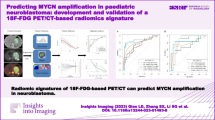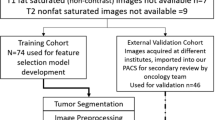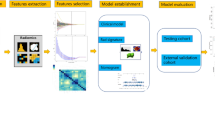Abstract
Objectives
To construct a CT-based radiomics signature and assess its performance in predicting MYCN amplification (MNA) in pediatric patients with neuroblastoma.
Methods
Seventy-eight pediatric patients with neuroblastoma were recruited (55 in training cohort and 23 in test cohort). Radiomics features were extracted automatically from the region of interest (ROI) manually delineated on the three-phase computed tomography (CT) images. Selected radiomics features were retained to construct radiomics signature and a radiomics score (rad-score) was calculated by using the radiomics signature–based formula. A clinical model was established with clinical factors, including clinicopathological data, and CT image features. A combined nomogram was developed with the incorporation of a radiomics signature and clinical factors. The predictive performance was assessed by receiver operating characteristics curve (ROC) analysis and decision curve analysis (DCA).
Results
The radiomics signature was constructed using 7 selected radiomics features. The clinical radiomics nomogram, which was based on the radiomics signature and two clinical factors, showed superior predictive performance compared with the clinical model alone (area under the curve (AUC) in the training cohort: 0.95 vs. 0.82, the test cohort: 0.91 vs. 0.70). The clinical utility of clinical radiomics nomogram was confirmed by DCA.
Conclusions
This proposed CT-based radiomics signature was able to predict MNA. Combining the radiomics signature with clinical factors outperformed using clinical model alone for MNA prediction.
Key Points
• A CT-based radiomics signature has the ability to predict MYCN amplification (MNA) in neuroblastoma.
• Both pre- and post-contrast CT images are valuable in predicting MNA.
• Associating the radiomics signature with clinical factors improved the predictive performance of MNA, compared with clinical model alone.






Similar content being viewed by others
Abbreviations
- AIC:
-
Akaike information criterion
- AUC:
-
Area under the curve
- CI:
-
Confidence interval
- CT:
-
Computed tomography
- DCA:
-
Decision curve analysis
- GLRLM:
-
Gray level run length matrix
- ICCs:
-
Inter-/intra-observer class correlation coefficients
- INRGSS:
-
International Neuroblastoma Risk Group Staging System
- LASSO:
-
Least absolute shrinkage and selection operator
- MDCT:
-
Multidetector computed tomography
- MNA:
-
MYCN amplification
- MRMR:
-
Maximum relevance minimum redundancy
- OR:
-
Odds ratio
- Rad-score:
-
Radiomics score
- ROC:
-
Receiver operator characteristic
- ROI:
-
Region of interest
- SMOTE:
-
Synthetic minority oversampling technique
References
Ahmed AA, Zhang L, Reddivalla N, Hetherington M (2017) Neuroblastoma in children: update on clinicopathologic and genetic prognostic factors. Pediatr Hematol Oncol 34:165–185
Campbell K, Gastier-Foster JM, Mann M et al (2017) Association of MYCN copy number with clinical features, tumor biology, and outcomes in neuroblastoma: a report from the Children’s Oncology Group. Cancer 123:4224–4235
Cohn SL, Pearson AD, London WB et al (2009) The International Neuroblastoma Risk Group (INRG) classification system: an INRG task force report. J Clin Oncol 27:289–297
Ambros PF, Ambros IM, Brodeur GM et al (2009) International consensus for neuroblastoma molecular diagnostics: report from the International Neuroblastoma Risk Group (INRG) biology committee. Br J Cancer 100:1471–1482
Mullassery D, Sharma V, Salim A et al (2014) Open versus needle biopsy in diagnosing neuroblastoma. J Pediatr Surg 49:1505–1507
Marrano P, Irwin MS, Thorner PS (2017) Heterogeneity of MYCN amplification in neuroblastoma at diagnosis, treatment, relapse, and metastasis. Genes Chromosomes Cancer 56:28–41
Pinker K, Shitano F, Sala E et al (2018) Background, current role, and potential applications of radiogenomics. J Magn Reson Imaging 47:604–620
Brisse HJ, Blanc T, Schleiermacher G et al (2017) Radiogenomics of neuroblastomas: relationships between imaging phenotypes, tumor genomic profile and survival. PLoS One 12:e0185190
Blanchet EM, Gabriel S, Martucci V et al (2014) 18F-FDG PET/CT as a predictor of hereditary head and neck paragangliomas. Eur J Clin Invest 44:325–332
Venkatesan AM, Trivedi H, Adams KT, Kebebew E, Pacak K, Hughes MS (2011) Comparison of clinical and imaging features in succinate dehydrogenase-positive versus sporadic paragangliomas. Surgery 150:1186–1193
Digumarthy SR, Padole AM, Gullo RL, Sequist LV, Kalra MK (2019) Can CT radiomic analysis in NSCLC predict histology and EGFR mutation status? Medicine (Baltimore) 98:e13963
Taguchi N, Oda S, Yokota Y et al (2019) CT texture analysis for the prediction of KRAS mutation status in colorectal cancer via a machine learning approach. Eur J Radiol 118:38–43
Kocak B, Durmaz ES, Ates E, Ulusan MB (2019) Radiogenomics in clear cell renal cell carcinoma: machine learning-based high-dimensional quantitative CT texture analysis in predicting PBRM1 mutation status. AJR Am J Roentgenol 212:W55–w63
Shimada H, Ambros IM, Dehner LP, Hata J, Joshi VV, Roald B (1999) Terminology and morphologic criteria of neuroblastic tumors: recommendations by the International Neuroblastoma Pathology Committee. Cancer 86:349–363
Bai RJ, Cui JG, Dong DD, Gao H (2017) Expert consensus on the diagnostic reference level of CT radiation dose. Chin J Radiol 51:817–822
Monclair T, Brodeur GM, Ambros PF et al (2009) The International Neuroblastoma Risk Group (INRG) staging system: an INRG task force report. J Clin Oncol 27:298–303
Collins GS, Reitsma JB, Altman DG, Moons KG (2015) Transparent reporting of a multivariable prediction model for individual prognosis or diagnosis (TRIPOD): the TRIPOD statement. BMJ 350:g7594
Ding C, Peng H (2005) Minimum redundancy feature selection from microarray gene expression data. J Bioinform Comput Biol 3:185–205
Sauerbrei W, Royston P, Binder H (2007) Selection of important variables and determination of functional form for continuous predictors in multivariable model building. Stat Med 26:5512–5528
Blagus R, Lusa L (2013) SMOTE for high-dimensional class-imbalanced data. BMC Bioinformatics 14:106
Castellano G, Bonilha L, Li LM, Cendes F (2004) Texture analysis of medical images. Clin Radiol 59:1061–1069
Kim HS, Kim YJ, Kim KG, Park JS (2019) Preoperative CT texture features predict prognosis after curative resection in pancreatic cancer. Sci Rep 9:17389
Huang M, Weiss WA (2013) Neuroblastoma and MYCN. Cold Spring Harb Perspect Med 3:a014415
Lambin P, Leijenaar RTH, Deist TM et al (2017) Radiomics: the bridge between medical imaging and personalized medicine. Nat Rev Clin Oncol 14:749–762
Xu X, Zhang X, Tian Q et al (2019) Quantitative identification of nonmuscle-invasive and muscle-invasive bladder carcinomas: a multiparametric MRI radiomics analysis. J Magn Reson Imaging 49:1489–1498
Liu S, He J, Liu S et al (2020) Radiomics analysis using contrast-enhanced CT for preoperative prediction of occult peritoneal metastasis in advanced gastric cancer. Eur Radiol 30:239–246
Kocak B, Durmaz ES, Ates E, Kaya OK, Kilickesmez O (2019) Unenhanced CT texture analysis of clear cell renal cell carcinomas: a machine learning-based study for predicting histopathologic nuclear grade. AJR Am J Roentgenol. https://doi.org/10.2214/ajr.18.20742:W1-w8
Funding
This study has received from the National Key Research and Development Program of China (No. 2017YFC0109003).
Author information
Authors and Affiliations
Corresponding author
Ethics declarations
Guarantor
The scientific guarantor of this publication is Dengbin Wang, MD, PhD, the chief of department of radiology, Xinhua hospital affiliated to Shanghai Jiao Tong University School of Medicine.
Conflict of interest
One of the authors of this manuscript (Shaofeng Duan) is an employee of GE Healthcare. The remaining authors declare no relationships with any companies whose products or services may be related to the subject matter of the article.
Statistics and biometry
Shaofeng Duan kindly provided statistical advice for this manuscript.
Informed consent
Written informed consent was waived by the Institutional Review Board.
Ethical approval
Institutional Review Board approval was obtained.
Methodology
• retrospective
• diagnostic or prognostic study
• performed at one institution
Additional information
Publisher’s note
Springer Nature remains neutral with regard to jurisdictional claims in published maps and institutional affiliations.
Electronic supplementary material
ESM 1
(DOCX 567 kb)
Rights and permissions
About this article
Cite this article
Wu, H., Wu, C., Zheng, H. et al. Radiogenomics of neuroblastoma in pediatric patients: CT-based radiomics signature in predicting MYCN amplification. Eur Radiol 31, 3080–3089 (2021). https://doi.org/10.1007/s00330-020-07246-1
Received:
Revised:
Accepted:
Published:
Issue Date:
DOI: https://doi.org/10.1007/s00330-020-07246-1




